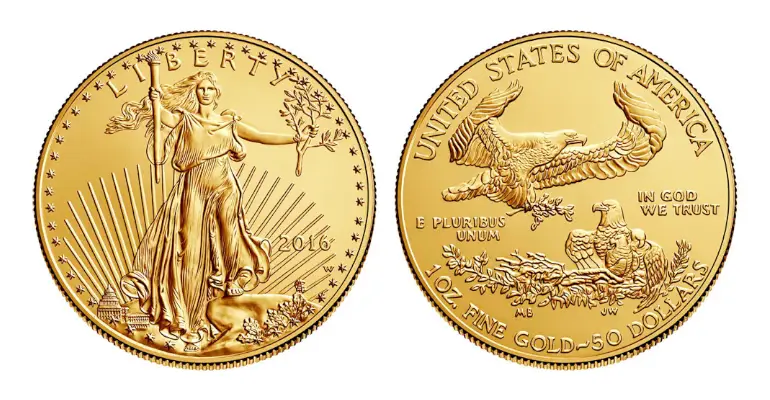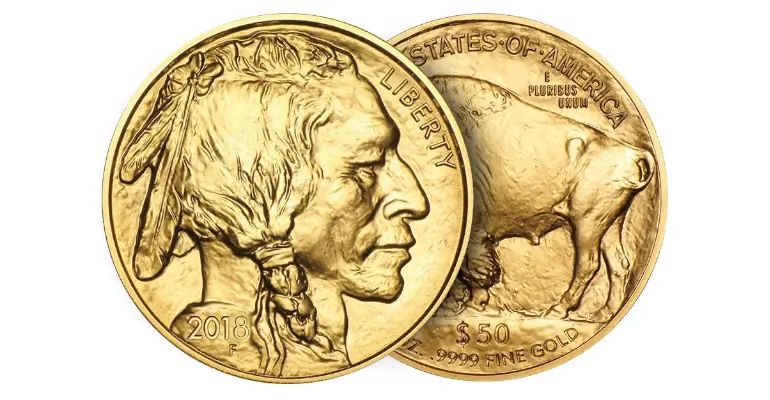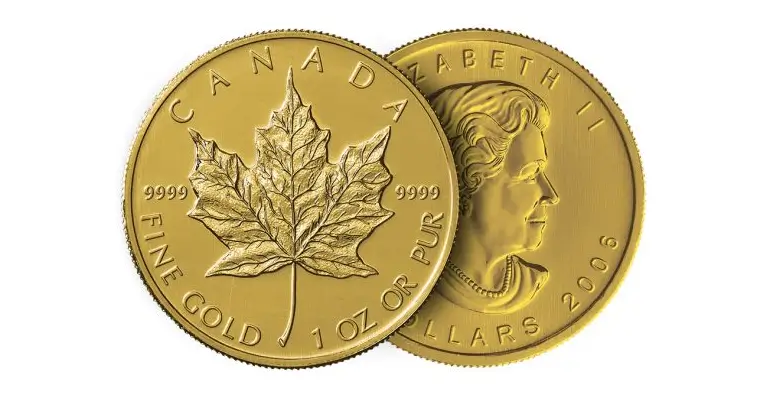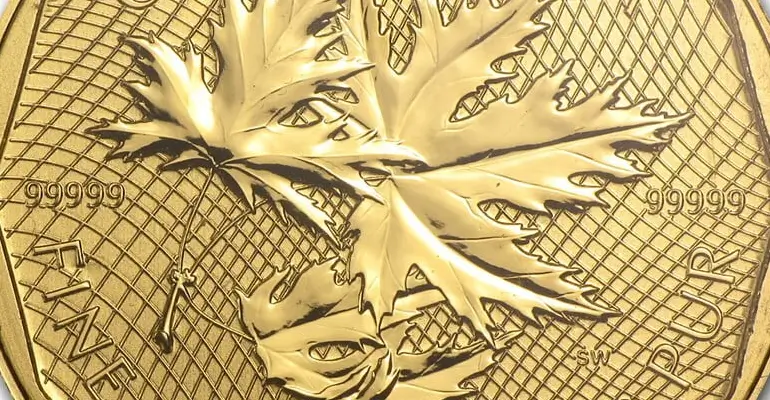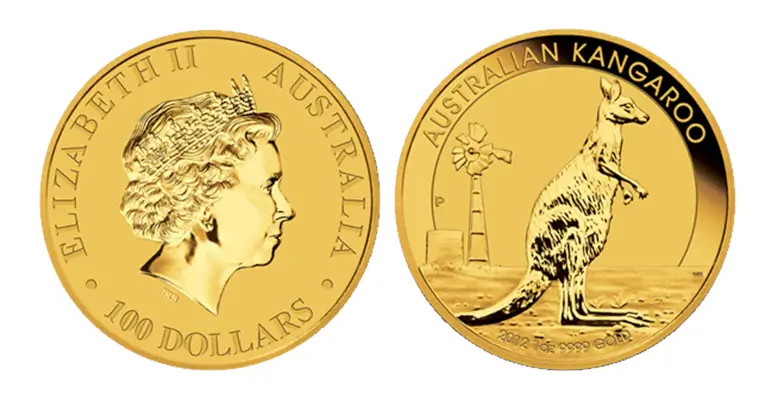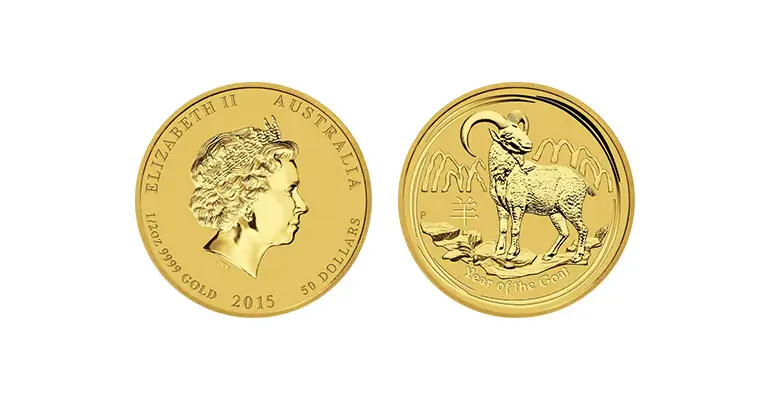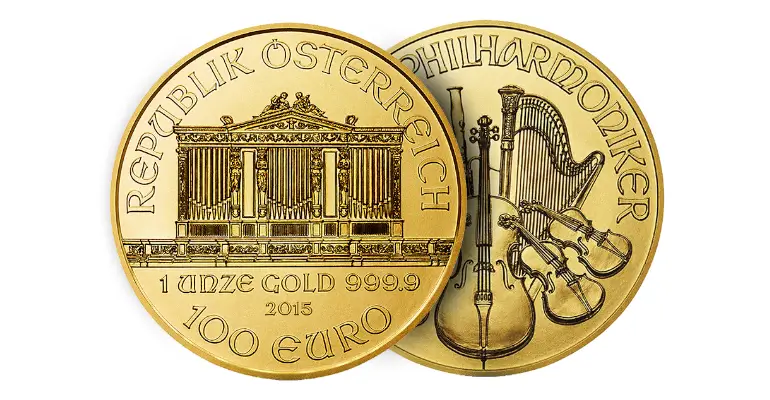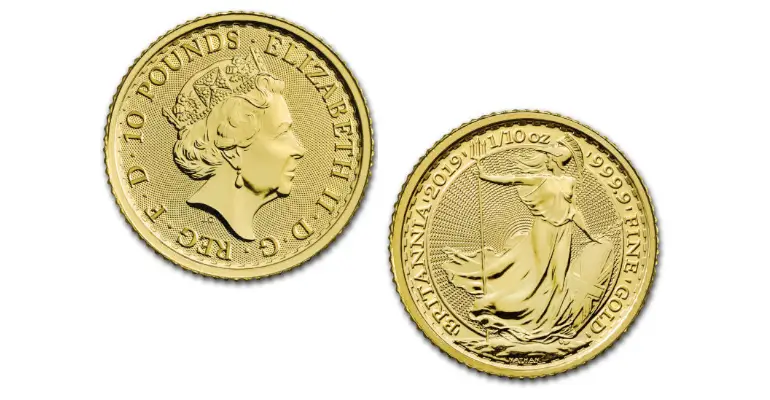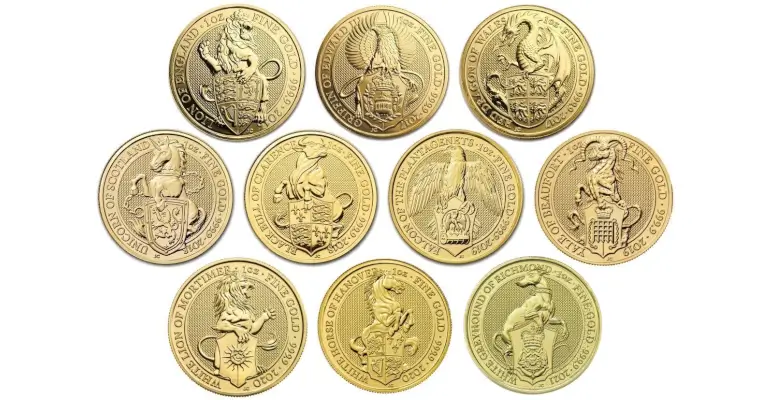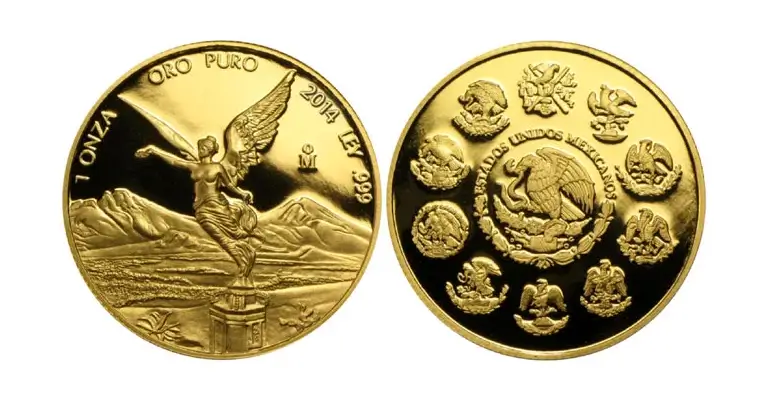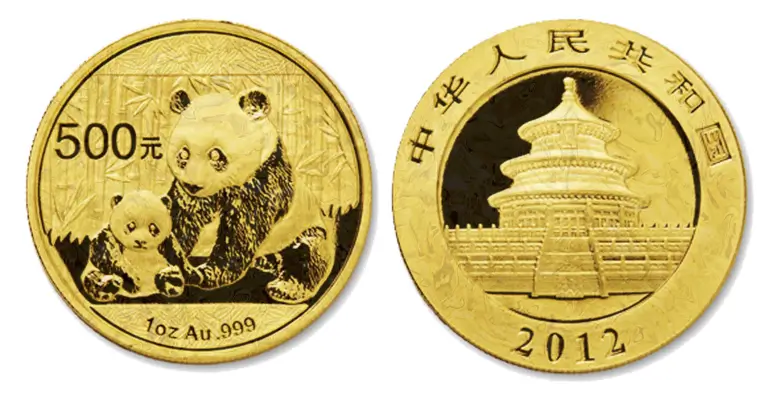Gold Coins: Invest in Gold Bullion Coins, Add to IRA, Buy Online
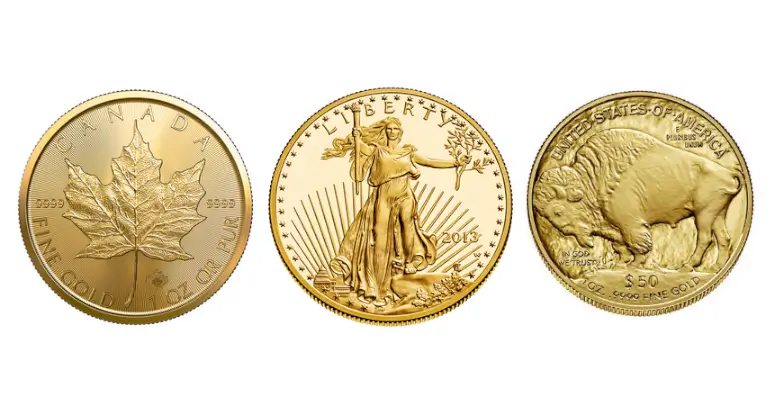
Investor-grade gold bullion coins appeal to investors for their gold content, purity, and legal tender status. These coins typically have a high gold purity level, often 22 karats or more.
Standard specifications include a gold purity range of 99.9% to 99.99%, weight options such as 1 oz, 1/2 oz, 1/4 oz, and diameters, for instance, 32.7 mm for a 1 oz coin. These coins are valued both as investment assets and collectors' items. Their intrinsic value stems from the gold content, while additional worth arises from factors like rarity, design, and collector demand.
American Eagle Gold Coins
The American Eagle Gold Coins, launched in 1986 by the United States Mint, are composed of 91.67% gold, 3% silver, and 5.33% copper. Available in sizes of 1 oz, 1/2 oz, 1/4 oz, and 1/10 oz, they have legal tender values of $50, $25, $10, and $5, respectively. The design is iconic, featuring Lady Liberty on the obverse and a male eagle carrying an olive branch on the reverse, flying towards a nest with a female eagle and hatchlings. This design combination makes them highly sought-after by collectors and investors alike.
American Buffalo Gold Coins
First issued in 2006, the American Buffalo Gold Coins are distinguished as the first 24-karat gold coins from the U.S. Mint, boasting a .9999 purity. Primarily available in a 1 oz denomination with a $50 face value, these coins feature a Native American profile on the obverse and an American buffalo on the reverse. Their appeal lies in the high gold content and the design's historical significance, inspired by James Earle Fraser's 1913 Type 1 Buffalo Nickel.
Canadian Maple Leaf Gold Coins
Introduced in 1979 by the Royal Canadian Mint, Canadian Maple Leaf Gold Coins are known for their high purity (.9999 gold). They are available in denominations of 1 oz, 1/2 oz, 1/4 oz, 1/10 oz, and 1/20 oz. The coins showcase the iconic maple leaf on the reverse and Queen Elizabeth II's portrait on the obverse. Their legal tender status in Canada, with face values proportional to size, and security features like radial lines and a micro-engraved laser mark, make them a secure and attractive investment.
Canadian .99999 Gold Coins
The Canadian .99999 Gold Coins stand out for their exceptional purity level, making them among the purest gold coins globally. Typically, these are special editions or commemorative issues, like the "Call of the Wild" series, featuring unique Canadian wildlife on the reverse. They are highly collectible due to limited mintages and often come with special presentation packaging.
Australian Kangaroo/Nugget Gold Coins
Produced by the Perth Mint and initially released in 1986 as Australian Nugget Gold Coins, these were later renamed Australian Kangaroo Gold Coins. Unique for their annually changing kangaroo design on the reverse and a portrait of Queen Elizabeth II on the obverse, these coins are available in sizes from 1/20 oz to 1 kg. They are recognized for their .9999 gold purity and legal tender status in Australia.
Australian Lunar Gold Coins
The Australian Lunar Gold Coins, issued by the Perth Mint, are part of a series celebrating the Chinese Zodiac. Each year, a new design corresponding to the zodiac animal is featured. These coins, known for their .9999 gold purity, come in sizes ranging from 1/20 oz to 1 kg, with denominations reflecting their weight. The series is favored among collectors for its annually changing designs and cultural significance, in addition to its investment value due to high gold content and limited minting.
Austrian Philharmonic Gold Coins
First introduced in 1989 by the Austrian Mint, the Austrian Philharmonic Gold Coins are a leading choice in Europe's gold bullion market. Struck in .9999 fine gold, they are available in 1 oz, 1/2 oz, 1/4 oz, and 1/10 oz denominations. The design, celebrating the Vienna Philharmonic Orchestra, features musical instruments on the reverse and the Great Organ of the Golden Hall in Vienna's Musikverein on the obverse. Their unique thematic design sets them apart in the bullion coin market.
British Britannia Gold Coins
Since their launch in 1987 by the Royal Mint, British Britannia Gold Coins have been known for depicting Britannia, a symbol of Britain's strength. Initially minted in 22 karat gold, they shifted to 24 karat (.9999 pure) gold in 2013. Available in denominations of 1 oz, 1/2 oz, 1/4 oz, and 1/10 oz, these coins feature Britannia with a trident and shield against a radial sunburst design, enhancing their appeal as both investment and collectible items.
British Queen's Beasts Gold Coins
Launched in 2016 by the Royal Mint, the British Queen's Beasts Gold Coin series celebrates the ten heraldic statues present at Queen Elizabeth II’s coronation. Each coin in this series, struck in .9999 fine gold, showcases a different heraldic beast, like the Lion of England or the Griffin of Edward III. Available in sizes such as 1 oz and 1/4 oz, these coins are sought for their combination of gold purity, historical significance, and artistic design.
Mexican Libertad Gold Coins
Produced by the Mexican Mint, the Mexican Libertad Gold Coins are unique in not having a face value but still being considered legal tender. Introduced in 1981, they are known for their .999 fine gold purity and feature the Winged Victory statue on the obverse and the Mexican Coat of Arms on the reverse. Available in sizes from 1/20 oz to 1 oz, these coins are popular among collectors and investors for their historical and cultural significance.
South African Krugerrand Gold Coins
Introduced in 1967, South African Krugerrand Gold Coins were the world's first modern bullion gold coins and remain highly traded. Made from a gold-copper alloy (22 karats), they have a distinct orange appearance. The coin displays Paul Kruger, South Africa’s first president, on the obverse, and a springbok antelope on the reverse. Available in 1 oz, 1/2 oz, 1/4 oz, and 1/10 oz denominations, Krugerrands are known for their durability and investment appeal.
Chinese Panda Gold Coins
Since their introduction in 1982 by the People's Republic of China, Chinese Panda Gold Coins have been unique for their annual design changes featuring the panda. Struck in .999 fine gold, these coins are available in sizes like 1 oz, 1/2 oz, 1/4 oz, and 1/20 oz, with face values in Yuan corresponding to their sizes. The reverse typically features the Temple of Heaven in Beijing, while the obverse showcases varying panda designs each year, adding to their collectibility and investment value.
British Gold Sovereign Coins
Dating back to 1817 and produced by the Royal Mint, British Gold Sovereign Coins are known for their design featuring St. George slaying a dragon. These coins contain 22 karat gold (0.917 purity) and weigh 7.98805 grams, with a nominal face value of one sovereign (£1). Sought for their historical significance and affordability for smaller investors, Gold Sovereigns also have a legal tender status in the United Kingdom, enhancing their appeal.
Pre-1933 US Gold Coins
Pre-1933 US Gold Coins encompass various denominations minted before the country abandoned the gold standard. These include the $20 Saint-Gaudens Double Eagle and the $10 Indian Head Eagle, struck in a 90% gold and 10% copper alloy. Collectors and investors value these coins for their historical significance, rarity, and representation of unique American history, along with their gold content.
Benefits to Investing in Bullion Gold Coins
Investing in bullion gold coins offers several benefits, including intrinsic value due to their gold content, which acts as a hedge against inflation and economic downturns. Gold coins are highly liquid, meaning they can be easily bought and sold worldwide, offering flexibility in investment. Additionally, owning physical gold coins provides a sense of security and tangibility, making them an important part of a diversified investment portfolio. Unlike digital or paper assets, they are devoid of counterparty risks.
1. Tangibility and Physical Ownership
Gold coins offer a tangible investment option, providing a physical asset that investors can hold and control directly, free from reliance on financial institutions or digital infrastructure. This tangibility brings psychological satisfaction and a sense of security to many investors. The physical ownership of gold coins allows for direct control over one's investment, adding an extra layer of reassurance.
2. Liquidity
One of the key advantages of investing in gold coins is their liquidity. Gold coins can be quickly converted into cash or traded for goods and services worldwide, thanks to their global recognition. This universal appeal aids in their liquidity, providing financial flexibility to investors, enabling them to respond promptly to market changes or personal financial needs.
3. Hedge Against Inflation and Economic Uncertainty
Gold coins serve as a hedge against inflation, retaining their value and purchasing power even when fiat currencies weaken. Historically, gold has performed well during periods of economic uncertainty, including recessions and high inflation. Gold coins provide stability in volatile markets and geopolitical uncertainties, offering a safer investment compared to more volatile options.
4. Portfolio Diversification Choice
Including gold coins in an investment portfolio is a means of diversification, reducing overall risk. Gold's price movements often differ from those of stocks and bonds, providing balance during market downturns. Gold coins offer exposure to a physical asset class, distinct from equities and fixed income, enhancing portfolio resilience against market fluctuations.
5. No Counterparty Risk
Owning physical gold coins comes with no counterparty risk. This means that their value does not depend on the promises or performance of another party, reducing the risk of default or bankruptcy that can affect other asset types like stocks or bonds. Direct ownership of gold coins eliminates concerns about management decisions or corporate governance issues impacting other investments.
Uncirculated Gold Coins
Uncirculated gold coins have never been used in commerce and retain their original mint condition. Collectors and investors find these coins appealing due to their pristine condition, rarity, and potential for appreciation in value. Factors like luster, strike quality, and the absence of wear or damage are crucial in grading and valuing uncirculated gold coins.
Proof Gold Coins
Proof gold coins are known for their exceptional finish, resulting from a special minting process that yields sharp details and a mirror-like surface. These coins are usually minted in limited quantities, making them more collectible and often more valuable than bullion counterparts. Proof coins are often presented and preserved in protective cases with a certificate of authenticity, appealing to both collectors and investors.
Numismatic Gold Coins
Numismatic gold coins are valued for their rarity, historical significance, and collector interest, beyond their gold content. Factors such as age, mintage numbers, historical context, and condition determine their value. Collecting numismatic gold coins involves understanding grading systems and the importance of provenance in establishing value.
Commemorative Gold Coins
Commemorative gold coins are issued to honor significant events, individuals, or milestones, featuring unique designs and limited mintage. These coins often hold sentimental value and can be part of themed collections while containing a specified amount of gold. Various themes and occasions for which commemorative gold coins are minted include historical anniversaries, national achievements, and notable figures.
Certified Gold Coins: Why Authentication Matters
Certification and authentication are crucial for gold coins, assuring their authenticity, purity, and condition. Reputable grading services like PCGS (Professional Coin Grading Service) and NGC (Numismatic Guaranty Corporation) provide certifications that significantly impact a coin’s market value and collectibility. Certified gold coins offer investors and collectors increased confidence in purchasing, potential for higher resale value, and protection against counterfeits.
Gold Coin Investment Strategies
Investing in gold coins involves aligning investments with individual financial goals and risk tolerance. A balance between collecting for numismatic value and investing for gold content is essential. Investors should consider potential long-term appreciation of different types of gold coins and be mindful of market trends when buying or selling. Factors like coin rarity, historical significance, and market demand are crucial in formulating investment strategies.
Long-Term Holding of Gold Coins
Long-term holding of gold coins is a strategy highlighting benefits as a hedge against inflation and market volatility. Patience is key, considering the historical appreciation of gold’s value, especially for rare or numismatic coins. This approach also encompasses aspects of estate planning and generational wealth transfer, positioning gold coins as tangible assets that can be easily stored and passed down.
Portfolio Diversification in Gold Coins
Gold coins play a significant role in diversifying investment portfolios, mitigating risk by spreading investments across different asset types. Gold often has an inverse relationship with other asset classes like stocks and bonds, providing stability in times of economic uncertainty. Financial experts recommend considering the optimal proportion of gold coins in an investment portfolio, tailored to individual investor profiles.
Collecting Rare Gold Coins
Collecting rare gold coins involves focusing on their historical, cultural, and artistic value, in addition to their gold content. It requires research and expertise to identify and acquire rare gold coins, understanding their historical context, rarity, and condition. Rare gold coins can appreciate significantly in value over time, making them an attractive option for both collectors and investors.
How to Invest/Buy Gold Coins
Investing in or buying gold coins involves considering factors like purity, weight, and design. Various avenues for purchasing gold coins include online dealers, auctions, coin shows, and local coin shops, each with its pros and cons. Due diligence in verifying the authenticity and value of gold coins is crucial, including checking certifications and consulting price guides.
Buying Gold Coins Through Dealers
Buying gold coins through dealers involves selecting reputable and experienced dealers. Advantages include expert advice, a wide selection, and possible authentication services. Potential downsides are higher prices compared to peer-to-peer transactions and the need for due diligence in verifying a dealer’s credibility.
Investing in a Gold Coin IRA
A Gold Coin Individual Retirement Account (IRA) allows for the inclusion of gold coins in a retirement portfolio. It involves specific IRS rules and regulations regarding eligible gold coins. Setting up and managing a Gold Coin IRA includes choosing an IRA custodian and a storage facility, highlighting the benefits for long-term retirement planning.
Purchasing Gold Coins Directly From Mints
Purchasing gold coins directly from the best coin mints in the world ensures authenticity and access to newly minted coins. Buying from mints offers a range of options, including limited edition and commemorative coins. However, potential drawbacks include limited resale options and possibly higher premiums over the spot price of gold.
Storing Gold Coins: Key Essentials
Securely storing gold coins is essential, considering factors like security, accessibility, and preservation conditions. Storage options include home storage, safety deposit boxes, and certified depositories, each with specific advantages. Regardless of the chosen method, the importance of insurance and discretion in storing gold coins is paramount to protect the investment.
At Home (Not For IRA)
Storing gold coins at home requires a secure and discreet location, such as a safe or hidden compartment. Advantages of home storage include immediate accessibility and no ongoing storage fees. However, risks like theft or damage must be considered, and adequate insurance coverage for the stored gold coins is essential for protection.
Safety Deposit Box (Not For IRA)
Safety deposit boxes in banks offer a high level of security for storing gold coins, protecting them from theft, fire, and flood. This option is cost-effective and adds the security of storing assets in a financial institution. Limitations include restricted access based on bank hours and the lack of insurance coverage by banks for the contents of the deposit box.
Certified Depository (IRA Allowed)
Using certified depositories for gold coin storage provides specialized services for secure storage, including vaults and advanced safety measures. Benefits include insurance coverage, professional management, and security against physical and environmental risks. Certified depositories are often used for storing gold coins that are part of an IRA, complying with IRS requirements for precious metal IRAs.
How to Safely Transport Gold Coins
Safely transporting gold coins involves ensuring security, discretion, and preserving the condition of the coins. Appropriate packaging materials, such as hard cases or coin tubes, should be used to protect coins from damage. Secure and insured transport methods are crucial, whether for personal transport or shipping, and precautions should be taken to maintain anonymity and safety.
Gold Coin Grading and Quality Impact on Value
The process of gold coin grading determines the coin’s condition, authenticity, and market value. Grading scales like the Sheldon Scale are used, and professional grading services such as NGC and PCGS play a significant role. Factors impacting grading and value include luster, strike, and the presence of scratches or blemishes.
How Gold Prices Affect Gold Coin Values
The market price of gold and the value of gold coins are closely linked, with fluctuations in gold prices impacting coin values. Contributing factors to this correlation include gold content in coins and investor sentiment towards gold. However, the value of collectible or rare gold coins may be influenced by factors beyond just gold price, such as rarity, demand, and historical significance.
Gold Coins vs Other Precious Metal Coins
Comparing gold coins with coins made from other precious metals like silver and platinum highlights differences in investment potential, market dynamics, and uses. Gold's historical role, stability, and performance during economic uncertainties make it a preferred choice for many investors. Silver compared to gold for example has a much higher industrial use. Other precious metals offer industrial uses, price volatility, and different investment opportunities in varying market conditions.
Gold Coins vs Gold Bars
The distinctions between investing in gold coins and gold bars include aspects like liquidity, divisibility, and premiums over the spot price of gold. Gold coins offer collectible and numismatic value, while gold bars typically have lower premiums and straightforward value assessment. Practical considerations in storage and transportation differ for coins and bars due to their sizes and shapes.
Most Popular Gold Coins For Investors
Popular gold coins among investors include the American Eagle, Canadian Maple Leaf, and South African Krugerrand, valued for their purity, design, and liquidity. Reasons for their popularity include global recognition, ease of trading, and government backing. Different investment strategies these coins suit range from short-term trading to long-term wealth preservation.
Most Counterfeited Gold Coins
Commonly counterfeited gold coins present risks to investors, with specific historical and rare coins often targeted. Counterfeiting methods include gold plating, core insertions, and alterations. Investors should use techniques like weight tests, size checks, and professional authentication services to identify counterfeit coins.
World Gold Coins: Country Specialties
Unique gold coins from various countries reflect cultural heritage and offer unique investment or collecting opportunities due to their rarity and demand. Coins like the Chinese Panda, with yearly design changes, and the British Sovereign, known for historical value, are examples. These country-specific coins are prized for their special features, designs, and historical significance.
Gold Coins vs Bitcoin
Comparing gold coins and Bitcoin involves analyzing aspects like tangibility, market volatility, historical performance, and regulatory environment. Gold coins offer advantages like physical ownership, historical stability, and acceptance as a hedge against economic instability. Bitcoin's characteristics include its digital nature, potential for high returns, and susceptibility to regulatory changes and technological factors.
Alternative Gold Bullion
Discover How to Effortlessly Rollover Gold Into Your IRA
Our free eBook covers everything you need to know before you start diverisfying your retirement with gold.
Disclaimer: Content on this website is not intended to be used as financial advice. It is not to be used as a recommendation to buy, sell, or trade an asset that requires a licensed broker. Consult a financial advisor.

